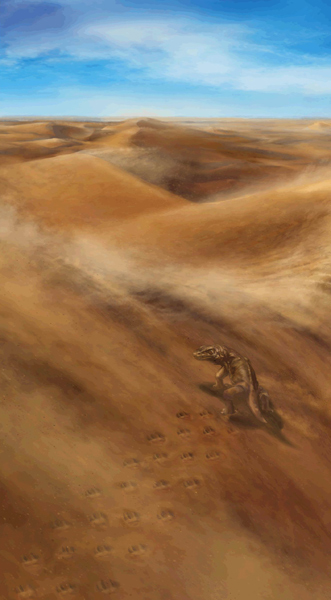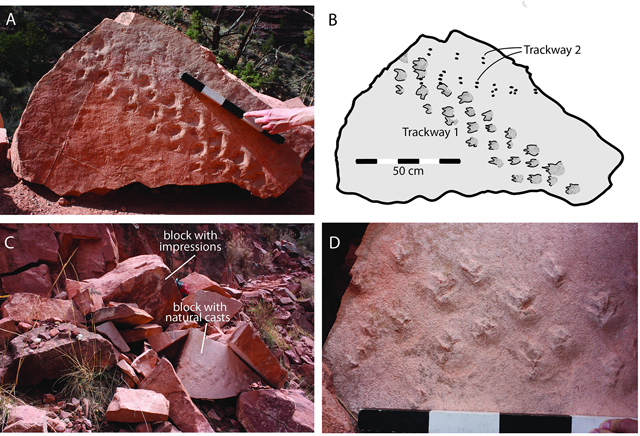Dramatic Rock Fall Reveals Ancient Fossilised Trackways in Arizona
Two Ancient Trackways Discovered in Arizona
A fortuitous rock fall on the Bright Angel Trail in the Grand Canyon National Park (Arizona), has revealed two ancient trace fossils that have been interpreted as the trackways created by small vertebrates as they climbed a steep sand dune. The sandstone blocks containing the fossilised trackways from the Manakacha Formation, a sub-unit of the extensive Supai Group, are the subject of a scientific paper published in the academic, on-line, open-access journal PLOS One.
Estimated to be around 313 million years old (Moscovian Age of the Pennsylvanian Epoch – Late Carboniferous), the fossilised trackways are thought to have been made by either basal diapsid reptile or a basal synapsid and are the first tetrapod tracks reported from the Manakacha Formation and the oldest known from the Grand Canyon region.
An Artist’s Reconstruction of the Tetrapod Ascending the Sand Dune

Picture credit: Emily Waldman
Ascending Sand Dunes
The rocks in this region are aeolian sandstones and the discovery of the two trackways document the earliest known occurrence of dunefield-dwelling amniotes. Lead author of the scientific paper, Steve Rowland (professor emeritus of geology at the University of Nevada), commented that these fossils demonstrate that by the Late Carboniferous, the first vertebrates capable of laying eggs out of water had adapted to desert habitats.
The Main Trackway, Line Drawing, Site of Rock Fall and Counterpart Slab

Picture credit: Rowland et al (PLOS One)
Side-stepping Ascent of a Steep Dune Revealed by Fossilised Trackways
The rock fall occurred close to a popular hiking trail and they were first spotted during a geology field trip to the Grand Canyon in 2016. The leader of that trip, professor Allan Krill sent a photograph of the tracks to the Department of Geology at the University of Nevada and Professor Rowland decided to investigate further. The tracks have been interpreted as showing the ascent of a dune slope at an angle of approximately 20 degrees, thus reducing the steepness of the climb.
The second trackway, a series of small rounded depressions in the rock suggest claw marks. It has been postulated that these marks are a deeper undertrackway, made some hours or days after the first track was produced, possibly by an animal of the same species as the first trackmaker.
Line Drawing of Main Trackway (1) with a Plotted Three-dimensional Track Interpretation

Picture credit: Rowland et al (PLOS One)
The scientists conclude that to traverse over the steep slope the little animal was moving, laterally one step at a time so that it always had its three other legs to support its body and to grip the surface. The transition across the dune may not have been particularly elegant but the 28 impressions that have been preserved may help to shed further light on the evolution of early amniotes, which are scarce in the Carboniferous/Early Permian fossil record of North America.
A Controversial Interpretation
Not everyone is convinced of the interpretation of the fossils by the research team which included Mario Caputo (Society for Sedimentary Geology) and Zachary Jensen (College of Southern Nevada).
A spokesperson representing the palaeontology programme at the Grand Canyon commented that there was a lot of disagreement amongst the scientific community when it came to interpreting fossil tracks and inferring animal behaviours from them. During the Late Carboniferous, this part of Arizona was a coastal-plain on the western edge of the super-continent of Pangaea. There were extensive dunefields in close proximity, the dunes being formed by the action of the wind (aeolian), occasionally exceptional tidal conditions, storms or other flooding events interrupted the aeolian deposition burying parts of the dunefield in fine mud.
The scientific paper: “Early adaptation to eolian sand dunes by basal amniotes is documented in two Pennsylvanian Grand Canyon trackways” by Stephen M. Rowland, Mario V. Caputo and Zachary A. Jensen published in the open-access, on-line journal PLOS One.
The Everything Dinosaur website: Everything Dinosaur.

